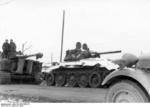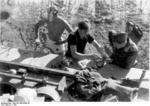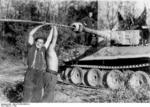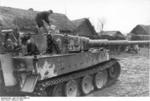PzKpfw VI Ausf. E 'Tiger I'
| Country | Germany |
| Manufacturer | Henschel und Sohn GmbH, Kassel, Germany |
| Primary Role | Heavy Tank |
Contributor: C. Peter Chen
ww2dbaseUp until the PzKpfw IV tank design, the German Army had always favored a balance between mobility, armor, and firepower, however, studies for designs focusing on certain elements existed, such as a project that started in 1937 for a new heavy tank design which did not have any production schedule associated with it. When the front line tankers reported that they were unexpectedly and significantly outgunned by new Soviet T-34 and KV-1 tanks, army leadership looked into its heavy tank programs with a renewed interest, seeking a specialized tank design that would focus on armor and firepower, while having a powerful engine so that mobility would not be sacrificed. On 26 May 1941, shortly prior to the German invasion of the Soviet Union, the firms Henschel and Porsche were already requested to submit designs for such a heavy tank by Jun 1942; the discovery of advanced Soviet tanks pushed the deadline date to 20 Apr. During this time, Ferdinand Porsche nicknamed this project "Tiger", which would evolve into a common name for the resulting project. Henschel's VK4501(H) design defeated Porsche's VK3001(P) design to win the contract. Henschel's design, which would later be designated Panzerkampfwagen VI or Tiger I, called for between 97 and 120 millimeter of armor on the front of the tank and 8.8-centimeter dual purpose guns as the primary weapon. These upgrades meant that, as combat experiences would soon show, these soon-to-be-deployed heavy tanks could penetrate the armor of enemy tanks at a long range where the enemy tanks' guns would not be able to penetrate that of the Tiger I tanks. While the heavy weight of the Tiger I design indeed took away from the performance, the Maybach engine still provided the Tiger tank competitive mobility. In fact, Tiger I heavy tanks could typically travel off-road in comparable speeds as the American M4 Sherman and Soviet T-34/85 tanks (Tiger I 20-25 kilometers per hour, M4 Sherman 17-32 km/h, T34/85 19 km/h), had a tighter turning radius (Tiger I 3.44 meters, M4 Sherman 18.6m, T-34/85 unknown), and had a lower ground pressure (Tiger I 0.735 kilograms per square centimeter, M4 Sherman 0.96 kg/cm2, T-34/85 0.85 kg/cm2). One notable weight-related weakness for the Tiger I heavy tank design was its inability to travel over many bridges; to address that issue, they were designed to be able to converted to wade through rivers up to 1.5 meters deep without a snorkel and 4 meters deep with a snorkel (the snorkel was deleted in later variants to reduce cost).
ww2dbaseProduction for the design, initially called PzKpfw VI Ausf. H, began in Aug 1942, and units were deployed to the field without extensive testing due to war demands, thus revisions were frequent, which slowed down production. Some of the revisions to the design included the removal of the frontal armor shield (Apr 1942), addition of bolted mudguards, addition of smoke discharge canisters (Aug 1942), and changing bolted mudguards to removable mudguards (Sep 1942). The designation later changed to PzKpfw VI Ausf. E in Mar 1943.
ww2dbaseTiger I tanks were first used in combat on 23 Sep 1942 near Leningrad, Russia; many of these first tanks broke down due to mechanical problems. These problems continued to plague them as they were deployed to North Africa. In fact, crews would continue to be plagued by mechanical issues through the end of the war. It was rare to see any unit equipped with Tiger I tanks to operate at full strength due to the extended maintenance and repair periods. Nevertheless, they were fearsome in combat. On 7 Jul 1943, tank commander SS-Oberscharführer Franz Staudegger of the 2nd Platoon, 13th Panzer Company, 1st SS Division Leibstandarte SS Adolf Hitler claimed to have engaged about 50 T-34 tanks and knocked out 22 of them. Similarly, SS-Haupsturmführer Michael Wittmann's platoon of schwere SS-Panzerabteilung 101 claimed to have destroyed over 20 Allied vehicles at the Villers-Bocage confrontation during the Allied Normandy invasion.
ww2dbaseWhen the Americans first encountered PzKpfw VI Tiger I heavy tanks, they decided to not devote any effort in dealing with them, because they were only seen in small numbers. The British took a different approach, upgrading anti-tank weaponry throughout the entire war to deal with the continual improvement in German armor. The Soviets also worked on developing heavier anti-tank weapons to deal with the new threat, culminating in the late-war SU-100 and SU-152 self-propelled guns with 100-millimeter tank guns and 152-millimeter howitzer guns, respectively, that could easily penetrate a Tiger I heavy tank's frontal armor at usual combat distances.
ww2dbaseIn 1943, Japan purchased several German tanks for study, which included a Tiger I heavy tank. It was never delivered to Japan, however, as it was difficult for German submarines break through Allied lines to the South Atlantic. As demands for tanks increased for Germany, the Japanese Army officially loaned the purchased Tiger I tank to the German military out of friendship.
ww2dbaseThe design's high cost kept the production numbers low; a Tiger I tank cost twice as much as a PzKpfw IV tank and four times as much as a StuG III assault gun. Only 1,355 PzKpfw VI Tiger I heavy tanks were built between Aug 1942 and Aug 1944. After Aug 1944, the Tiger II successor design which was finished in Jan 1944 completed the take over the production lines.
ww2dbaseSources:
David Fletcher, David Willey, and Mike Hayton, Tiger Tank Owners' Workshop Manual
Wikipedia
Last Major Revision: Feb 2010
PzKpfw VI Ausf. E 'Tiger I' Timeline
| 26 May 1941 | Adolf Hitler met with tank generals and tank designers at his residence Berghof in southern Germany. In a similar meeting three months prior he had asked for 75-millimeter guns for Panzer III and Panzer IV tanks. Because 75-millimeter guns relied on special tungsten shells, Hitler now asked for 88-millimeter guns to be used for future heavy tanks. He also demanded 100-millimeter frontal armor and 60-millimeter side armor. |
| 16 Sep 1942 | German 502nd Tank Battalion, stationed near Leningrad, Russia, received the first batch of Tiger I tanks. |
| 23 Sep 1942 | Tiger I tanks saw combat for the first time, operated by German 502nd Tank Battalion near Leningrad, Russia. |
| 21 Apr 1943 | Troops of 48th Battalion of British Royal Tank Regiment captured German Tiger I heavy tank "131" near Medjez-el-Bab, Tunisia. |
| 8 Oct 1943 | British merchant ship Ocean Strength arrived at Glasgow, Scotland, United Kingdom with a supply of iron ore and captured German Tiger I heavy tank "131". |
| 20 Oct 1943 | Captured German Tiger I heavy tank "131" arrived at the village of Chobham, Surrey, England, United Kingdom via a Scammell 100-ton truck. |
| 25 Sep 1951 | Tiger I heavy tank "131", captured by British troops in 1943, was given to the Tank Museum in Bovington Camp, Dorset, England, United Kingdom. |
SPECIFICATIONS
Ausf E
| Machinery | One Maybach HL 210 P45 water-cooled V-12 engine rated at 650hp |
| Suspension | Transverse torsion bars |
| Armament | 1x8.8cm KwK 36 L/56 tank gun (92 rounds), 1x7.92mm coaxial MG34 machine gun, 1x7.92mm ball-mounted MG34 machine gun |
| Armor | 97mm hull upper front, 102mm hull lower front, 82mm hull upper side, 62mm hull lower side, 82mm hull rear, 26mm hull top/bottom, 102mm turret front, 82mm turret side/rear, 120mm gun mantlet, 26mm turret top |
| Crew | 5 |
| Length | 6.32 m |
| Width | 3.72 m |
| Height | 1.78 m |
| Weight | 56.0 t |
| Speed | 20 km/h off-road; 45 km/h on-road |
| Range | 80 km off-road; 125 km on-road |
Photographs
 |  |  |  |
Please consider supporting us on Patreon. Even $1 per month will go a long way! Thank you. Please help us spread the word: Stay updated with WW2DB: |
Visitor Submitted Comments
17 Dec 2009 12:49:43 PM
Production of the Tiger was slow about 25 tanks per month, but peaked to 104 per month
by 1944. German Industry fell short in its
production of the Tiger, for many reasons
man hours to build, cost, it was just over-
engineered.
The Tiger was a powerful machine, but it had
too many weaknesses mechanically, it was just
underpowered, it was heavy over 60 tons!,
short operating range, slow speed.
On the other hand, it was a machine designed
for the attack, needed air support, but was
slow and this could hold up the Division when
it needed to move fast and flank the enemy.
Against other tanks, it was a tanker's worst
nightmare.
Over 1,000 Tigers took part in battles on the
Eastern Front, and destroyed over 8,000
Russian tanks, but they were just too few to
make any difference.
The kill ratio was high in favor of the Tiger, but the Russian could make up those
losses and build thousands of T-34'S and the
Germans could only build Hundreds, such low
production does not win wars,or support the Army in the field.
The design was never copied because it was just too complex for the cost of one Tiger
the Russians could out produce the Germans
in the number of tanks they could build. Tanks built during wartime have a operating
time in hours, days, months before they are
knocked out of action or destroyed.
During one 6 hour battle on the Eastern Front one Tiger was hit over 200 times, and was damaged, but it was able to drive back
40 miles to repair. As the Allies were moving through Normandy a few Tigers and
Panthers were able to knock out 80 Sherman Tanks, before being destroyed.
16 Jul 2010 06:36:26 PM
Each Tiger cost 250,000 marks, and each
Tiger lost in combat sometimes with highly
experienced crews, both were difficult to replace.
By the end of the war,the Russian heavy tank Joseph Stalin II, and the American Pershing
tank outclassed the Tiger.
16 Jul 2010 07:48:31 PM
"The(Real)Tiger and the(Reel)Tiger"
The Tiger tanks featured in the WWII Movie
"Saving Private Ryan", were reproductions
the vehicles were built on Russian T-34 tank
chassis.
If you look close you can see the(Reel)tanks have five main road wheels repo T-34's.
The(Real)Tiger had overlapping road wheels.
Operational Tiger tanks, are rare, and could
not be used in the movie let alone be destroyed!
The (Real)Tiger tank, had armored glass to
protect the driver. This would have prevented
Captain Miller (Tom Hanks) from sticking his
submachinegun into the viewport.
The use of a .45 Automatic against a Tiger,
I'm not gonna go there. If someone has any
information post it on the ww2bd I would like
to know.
The use of the Tiger in the movie, does much
more to do with its reputation, than it does
with Historical accuracy.
The Tiger's had markings of 1st.SS Panzer this unit would not have been near the
Merderet River, June 13, 1944.
30 Jul 2010 07:57:28 PM
ACHTUNG TIGER!
Did you know...
The Tiger tank, was developed on Hitler's
Birthday in 1942.
The first Tiger tanks the Allies faced were
in Tunisia, 75mm rounds bounced off firing
at fifty meters away. Dispite its design
flaws, the Tiger was a terror weapon, and
earned itself a reputation.
It was expensive to build in fact, German
Industry could build (4) StuG assault guns
for the price of one Tiger.
A Battle Tank must have three things going
for it:
Firepower
Armor
Manueverability
The Tiger had only the first two, as for its manueverability, it was slow top speed was
23mph, it was heavy and it suffered from
engine and suspension problems.
The Tiger was a breakthrough weapon it needed its flanks protected by Infantry and
other tanks, it also needed air-support.
The Germans didn't teach the world how to use
tanks, to showed the world how to use them.
Final note, I don't claim to be an expert,
and from time to time I'll get dissenting
opinions, all I ask is to use some courtesy.
Bill
Next time, your driving your automobile try
driving at 23mph / 37km/h, you'll get there.
18 Nov 2010 03:11:28 PM
Enter the Elefant, this vehicle was designed
by Ferdinand Porsche, used as a heavy tank
destroyed.
Ninty One (91) were built over-engineered it
had high fuel consumption, poor overall performance and mechanical problems maximum
speed 10km/h off road, and 30km/h 19mph on
road.
It was powered by two 300hp Mayback gasoline
engines. During the Battle of Kursk in 1943
many of the Elefant's broke down, destroyed by mines, or by Soviet infantry attacks.
Within the first four days of the Battle,
half were out of action.
WHAT NO MACHINE GUNS!
The Elefant had one big problem, it didn't
have any machine guns for protection against
infantry attack, the Germans couldn't support
each other by firing at the Soviet infantry
climbing on the tanks.
LETS OVER-ENGINEER IT SOMEMORE
The surviving vehicles were modified with
machine guns for protection, anti-tank paste
called Zimmerit was applied, other design
changes and modification added the weight to 70 tons!
Another variant an armored recovery vehicle they were rebuilt from damaged vehicles.
Today you can see a Elefant/Ferdinand at the
US Army Ordnance Museum, Aberdeen, Maryland
18 Nov 2010 06:27:43 PM
THE ARMORED DINOSAUR:
The Elefant/Ferdinand was armed with the
famous 88mm gun, after the Battle of Kursk
many were modified and for self-defence
they carried 2x7.92mm MG-34 machine guns
with 6,200 rounds of ammo.
More armor was added,the front armored plate was 3600lbs! the Elefant had a crew of six
to operate her.
The Elefant's 88mm had about 50 rounds, and gave the Elefant superior firepower, but I'm sure crews carried more than that.
Some crews even mounted a third machine gun on top of the commanders position, and added
even more ammo, those MG-34s put out a lot of
lead. Elefants were given a covering of
anti-magnetic paste called Zmmerit, to keep
those mines from sticking to the hull.
During the Battle of Kursk about twenty of the Elefants were lost to Russian anti-tank teams. Others were abandoned due to mechanical failure.
The first Elefants didn't have any machine
guns for protection or, to provide covering fire for each against the Russian infantry
climbing on top and place a mine to knock it
out. The slow speed, made them a target and others were lost to mechanical problems.
The Germans wasted a lot of time and material
on over-engineered machines, the more complex
the more things that can go wrong.
Last four Elefant's took part in the defence
of Berlin, April 1945.
The Elefant at the US Army Ordnance Museum
Aberdeen, Maryland USA, was captured at Anzio, Italy. It has been restored complete
with Battle damage.
The other Elefant is at the Russian Tank Museum Kubinka, Russia. It was captured at
the Battle of Kursk.
4 Jan 2011 06:57:57 PM
Can you imagine a tank larger and heaver than
a Tiger or even the King Tiger. It wasn't built but it could have been a monster, from
a monsterous regime.
KRUPP LANDKREUZER P.1000 RATTA (RAT)
This was a monster of 1000 tons development
started in 1943, but no prototypes would ever leave the drawing boards. Think about it
a vehicle 1000 tons/2,000,000 pounds
WUNDERWAFFE:
It would have been armed w/2x280mm naval guns, and its secondary armament would have been 1x128mm gun, 8x20mm cannons and 2x15mm cannons.
Powered by 8xDaimler-Benz 20-cylinder diesel
engines. These are the same engines, that powered the German E-boats and U-boats the
with a top speed 40 km/h about 25mph I would guess maybe on even ground, over rough ground about 15mph, but that's my guess.
How could you support such a machine in the field, were could you deploy it, hide it and
maintain it. It would have been crewed by over 20 men.
I can imagine to knock it out you would have to drop the RAFs 10 ton Tall Boy "Grandslam" Bomb on it.
BUT WAIT, THERE'S MORE!
The smaller brother named the Maus (Mouse) or
the Panzerkampfwagen VIII went on to become the largest tank built in prototype form only, no production machines were ever built
The Maus was 100 tons, but ballooned to 180 tons, armor was 31 inches thick, or 800mm!
armed w/ 1x128mm gun.
Another design was the E-100 similar in design to the Mous, but was smaller none were built, it was in prototype form only.
22 Feb 2011 10:20:08 AM
SACRIFICES AT HOME:
Mrs. Niland received three telegrams, from the Dept. of the Army, notifying her of the
two sons killed in action, and one missing in action.
First son, Robert died in Normandy June 6, 1944.
Second son, Preston died June 7, 1944.
Third son, Eddie reported missing in the Pacific but, was later rescued from a POW camp.
Forth son Fritz was sent back to the USA. The Niland story, was the basis for the WWII film Saving Private Ryan.
How many thousands of families suffered such loss, another reason they are call
"THE GREATEST GENERATION".
20 Apr 2016 01:26:05 AM
Like any new tank, the Tiger suffered from mechanical problems, but they were solved. In 1944, currently some 70 % of the Tiger tanks were available : this heavy tank was then as reliable as a medium one (see Thomas L. Jentz' book).
Its performances were very good for an heavy tank, hardly lower than those of a medium tank.
Its price, 250,000 RM, (c. US$ 95,000), was very high, but, compared to a medium tank (c US$ 50,000 for a Sherman), cheap, as a Tiger, on the battlefield, was equal to some four Allies tanks.
However, it wasn't good enough to counterbalance the Allies gigantic number.
8 Feb 2018 10:01:59 AM
good content
22 Feb 2020 09:43:37 AM
good content
13 Feb 2023 09:22:48 AM
doesn't the tiger have a howitzer variant because my great grandpa was a German SS tancrewman and he stats that his tiger had a 105mm howitzer main gun is this a valid statement.
9 May 2023 06:17:36 AM
They used Tiger 131 in the Movie Fury, all of the tanks in that movie were restored and did move
All visitor submitted comments are opinions of those making the submissions and do not reflect views of WW2DB.

» Tiger Tank: Owners' Workshop Manual
 |
- » 1,171 biographies
- » 337 events
- » 44,911 timeline entries
- » 1,245 ships
- » 350 aircraft models
- » 207 vehicle models
- » 376 weapon models
- » 123 historical documents
- » 261 facilities
- » 470 book reviews
- » 28,521 photos
- » 365 maps
Winston Churchill
Please consider supporting us on Patreon. Even $1 a month will go a long way. Thank you!
Or, please support us by purchasing some WW2DB merchandise at TeeSpring, Thank you!
7 Dec 2009 04:32:05 PM
The Tiger, or PzKpfw VI was the Wehrmacht's
answer to the Russian T-34 and KV Tanks.
However,Porsche and Henschel turned to the designs and prototypes they have been working
on since 1937. The Henschel design did not
have sloping armor, but it was heavily armored, and mounted the 3.5 inch /8.8 cm
weapon the famous 88!, this weapon was able to penetrate the armor of any opponent.
Production started in 1942 the first Tigers
were sent to North Afrika and the Eastern Front.
As a result of hasty development, the tank
was mechanically unrelible, it was heavy at 60 tons However once the problems were taken care of, the Tiger proved to be a greatly
feared weapon. The thickness of its armor
of 3.9 in/100mm at the front,and 3.1 in/80mm
at the sides meant it could take hits, and
continue to fight, the 88mm gun could destroy a Russian T-34 at a mile or 1.5km
away. During one battle, a single Tiger was able to destroy 25 Allied Tanks, and holding
up an entire division,before it was destroyed
Production was around 1,354 not enough of them, but consider the legendary reputation the tank had acquired. The numbers were too few, for them to really make any difference.
Because of its weight at 60 tons, it could not cross many bridges. Transport by rail,it took hours to load a Tiger on a flatcar, and needed special equipment.
When a Tiger broke down, the only machine
that could do the towing was another Tiger!
A number of special recovery Tigers were built. Another variant was the "Sturmtiger"
the turret was replaced with an armor plated superstructure mounting a 15in/38cm rocket
mortar 18 of these weapons were built before the end of the war.
Today you can see a Tiger and a Sturmtiger on display at the Aberdeen Proving Ground.
Other Tigers are on display in Europe, at the British Army Tank Museum and the French Army Tank Museum, the French keep a number of German tanks and other vehicles in working condition.